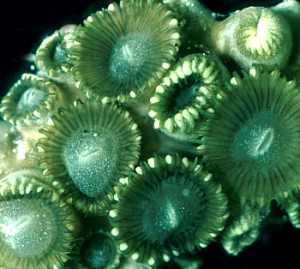
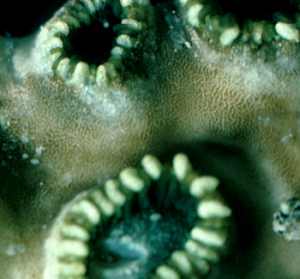
Feeding on Palythoa
PHOTO
Palythoa sp.. Upper photo showing fully extended polyps, and lower photo showing partially retracted polyps to five a view of the brown speckled appearance of the connective tissue. The brown colouration being the clusters of symbiotic zooxanthellae ingested by species of Aeolidiopsis. Lizard Island, Great Barrier Reef, June 1979. Photos: Bill Rudman.
Palythoa is a genus of colonial cnidarians [or coelenterates] belonging to the Order Zoanthidea. They are closely related to Sea Anemones and are best thought of as colonial sea anemones. Many tropical species have a symbiotic relationship with zooxanthellae and species of Palythoa incorporate sandgrains into the outer layers of their tissue. Three species of the aeolid genus Aeolidiopsis appear to feed exclusively on species of Palythoa. In fieldwork I have undertaken on the Great Barrier Reef, two colour forms of Palythoa were found, one predominantly greenish in colour, the other yellow brown. Unfortunately the state of the taxonomy of the zoantharians is such that it is impossible to discover if one or two species are involved. Specimens of Aeolidiopsis are associated only with the brown form.
A number of molluscan associates of Palythoa have been described (reviewed by Hadfield, 1976). Trench (1971) has shown that one species of Palythoa, P. townsleyi has a symbiotic relationship with zooxanthellae, and the large numbers of zooxanthellae in the epidermal tissues of the brown Palythoa on which Aeolidiopsis was found suggests that it also has a similar symbiosis. The individual polyps are connected by a thick coenochyme layer which has sand grains embedded in it. Zooxanthellae are found in all parts of the epidermis and some are also found in the gastrodermis lining the gut. The distribution of nematocysts is quite distinct and gives good evidence as to which part of the Palythoa colony the species of Aeolidiopsis feed on. The epithelium of the oral disc and inside of the tentacles is packed with small narrow nematocysts and spirocysts, probably associated with overpowering and capturing prey. On the outer side of the tentacles and the outer wall of the polyp the epithelium contains large nematocysts identical in structure to those in the cnidosacs of Aeolidiopsis ransoni and A. harrietae. From my observations, we know that the white form of A. ransoni burrows through the coenochyme layer connecting the polyps. The nematocysts in the cnidosacs of A. ransoni and in A. harrietae can only be obtained from the epidermis of the outer wall of the polyps and the connecting coenochyme. It is most probable that Aeolidiopsis feeds exclusively on this tissue. Zooxanthellae are also plentiful in this region and as in the alcyonarian-feeding genus Phyllodesmium, symbiotic zooxanthellae in Aeolidiopsis most surely come from the epithelium of the Palythoa colony.
See:
• photos of A. harrietae cnidosac.
• photo of A. ransoni cnidosac.
• page on solar powered opisthobranchs.
• A. ransoni - Biology and natural history.
• A. harrietae.
References:
• Hadfield, M.G. (1976) Mollusks associated with living tropical corals. Micronesica, 12(1): 133-148.
• Rudman, W.B. (1982) The taxonomy and biology of further aeolidacean and arminacean nudibranch molluscs with symbiotic zooxanthellae. Zoological Journal of the Linnean Society, 74: 147-196.
Rudman, W.B., 2002 (July 19) Feeding on Palythoa. [In] Sea Slug Forum. Australian Museum, Sydney. Available from http://www.seaslugforum.net/find/palyfeed
Related messages
Re: Polyp-feeding nudibranch
April 20, 2007
From: erik
Concerning message #18140:
I have these in my reef tank which hitchiked from a Zooanthid colony that I purchased at a LFS. I have killed about over 100 in the past few months and do believe they are breeding. I have found that dipping them in Flatworm Exit kills them. I add the double the dose and the nudibranch starts to become white and die. I will from now dip most of my corals in Flatworm exit before instroducing to my main or quarrantine tank. So far Flatworm Exit has not hurt my corals. You will be suprised how many will fall off your colony once you dip them. They can easily hide in the polyps without you noticing them.
Erik
erik_kinoshita@yahoo.com
Kinoshita, E., 2007 (Apr 20) Re: Polyp-feeding nudibranch. [Message in] Sea Slug Forum. Australian Museum, Sydney. Available from http://www.seaslugforum.net/find/19820Dear Erik,
I can't say I am in favour of killing nudibranchs like this, but thanks for the message. It at least gives us an idea of the dense populations that can be found a times on these palythoids.
Best wishes,
Bill Rudman
Aeolidiopsis sp. in aquarium
March 13, 2007
From: Scott Smith
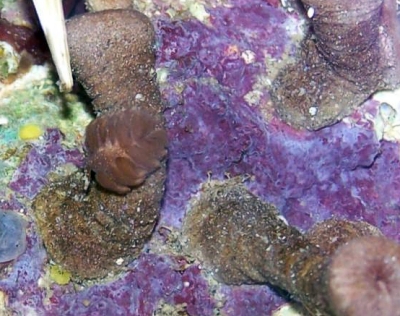
Here is a picture of what I believe is an aeolid nudibranch that hitch-hiked with some brown button polyps in my home tank. He is dorsal-ventrally flattened, which I have never personally seen in an aeolid (I'm not an expert either). There is a kabob skewer in the picture for size reference. I was told that the polyps were propagated and not wild caught so I unfortunately do not know the original locality. If it helps at all, the nudibranch is feeding on the brown polyps and killing them, but will not touch the blue ones seen in the same picture. The brown polyps used to be perfectly color matched until they started dying, so I assume that the nudibranch feeds primarily on this species. Can you point me in the right direction if nothing else as far as identifying this critter? Thank you for your time.
Locality: Wrightsville beach, North Carolina, 08 March 2007, Reef. Length: 10 mm. Photographer: Scott Smith.
Scott Smith
sas6523@uncw.edu
Smith, S.A., 2007 (Mar 13) Aeolidiopsis sp. in aquarium. [Message in] Sea Slug Forum. Australian Museum, Sydney. Available from http://www.seaslugforum.net/find/19632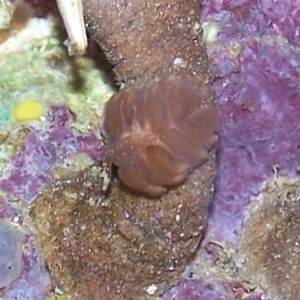
Dear Scott,
Have a look at the Palythoa feeding page. Your animal looks quite like the Palythoa -feeding aeolid Aeolidiopsis harrietae, but I can't see enough detail in your photo to be 100% sure. There seem to be a number of related aeolid nudibranchs which seem to travel with these cnidarians as they are sold to aquarium people such as you. Aeolidiopsis is solar-powered, harbouring and utilising zooxanthellae from the cnidarians they are feeding on. The close colour match between the nudibranch and the polyps, is because in both cases the background colour is caused by the symbiotic zooxanthellae. You mention it has a very flattened shape. This is an adaptation to solar power and photosynthesis - like leaves, these animals have become flattened and thin to maximise the amount of sunlight that strikes the surface.
Best wishes,
Bill Rudman
Re: Polyp-feeding nudibranch
November 7, 2006
From: Jack Kryppy
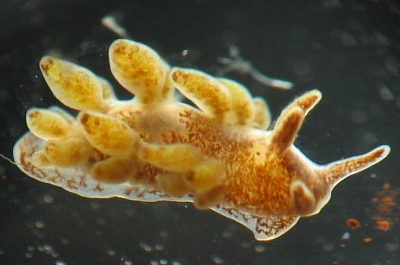
Concerning message #18048:
Hello,
I am currently breeding the unidentified zoanthid eating aeolid. They are very interesting creatures which take on the color of the zoanthid they are feeding on. I'm tempted to feed them some red so I can get a christmas themed picture. :)
I have a page setup with photos of the specimens I have gathered and some other pictures related to them. The pictures are compressed but I can provide them in original resolution if anyone is interested.
http://s56.photobucket.com/albums/g167/kr-yppy/nudi/
I'm including my favorite pics with this post. Am I seeing eyes on this guy or is that just coloration?
Locality: unknown. Length: 1 - 5mm observed . Photographer: Jack Kryppy.
Jack Kryppy
kryppy@gmail.com
Kryppy, J, 2006 (Nov 7) Re: Polyp-feeding nudibranch. [Message in] Sea Slug Forum. Australian Museum, Sydney. Available from http://www.seaslugforum.net/find/18140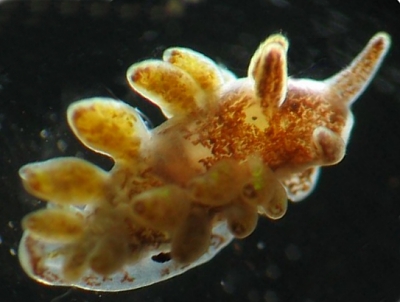
Thanks Jack,
Yes the black speck is an eye. I suspect the brown speckling scattered over the body wall and the foot are branches of the digestive gland which suggests that this is a solar powered species. It would be interesting to know if you find any egg masses. It is possible these are juveniles of a larger species, but I suspect your animals may be full sized.
Best wishes,
Bill Rudman
Re: Polyp-feeding nudibranch
October 27, 2006
From: David Sherrer
Concerning message #8581:
I have small sea-slugs that recently appeared in my 10 year old reef tank that look just like the ones shown on this page. The first one was spotted about 6 weeks ago and was removed. Small ones are 1/8" with adults up to 7 - 8 mm. In a period of three weeks they have eaten about 7 square inches of a 4 year old, formerly thriving zooanthid colony. They have reproduced to the extent that I removed about 50 tonight in 30 min with a syphon. They hide below the open and closed polyps are are clearly eating them. There is no question this is a pest species for reef tank owners that should be removed immediately unless you goal is to propagate small brown sea-slugs. If anyone knows what will eat or kill these animals before they take down years of growth in the rest of my tank, please let me know.
David Sherrer
Radford, VA
freed42002@yahoo.com
Sherrer, D., 2006 (Oct 27) Re: Polyp-feeding nudibranch. [Message in] Sea Slug Forum. Australian Museum, Sydney. Available from http://www.seaslugforum.net/find/18048Dear David,
I guess to you this is a catastrophe, but to me it is very interesting. This is almost certainly an unnamed species. Clearly you must have recently introduced some new rock or zoanthid to your aquarium, as these animals do not appear out of thin air. I am afraid that there are no known animals which specifically target aeolid nudibranchs.
Best wishes,
Bill Rudman
Re: Perhaps a gorgonian feeder?
August 26, 2006
From: Leslie Harris
Concerning message #17487:
Hi Bill --
Although unnamed, this animal is well known as a dreaded pest in reef aquaria. Desperate pleas for help from afflicted reefers frequently show up on web boards. It usually arrives in tanks as a hitchhiker on zoanthids or live rock from the Indo-Pacific. There are reports of it on other soft corals as well. It reproduces easily and has an insatiable appetite much to the despair of zoanthid lovers. Unfortunately, accurate coral ids seem to be rare in the hobby so it's hard to say what species it feeds on.
Cheers,
Leslie
lharris@nhm.org
Harris, L.H., 2006 (Aug 26) Re: Perhaps a gorgonian feeder?. [Message in] Sea Slug Forum. Australian Museum, Sydney. Available from http://www.seaslugforum.net/find/17613Thanks Leslie,
That's interesting to know. It's certainly not surprising to find that there is an aeolid eating zoanthids other than Palythoa - or perhaps Palythoa is one of the range of zoanthids it feeds on? Certainly from the shape of the animal it doesn't seem to be a juvenile of the species of Aeolidiopsis I was referring to, so it would be nice to get some specimens next time someone has an infestation in their tank.
Best wishes,
Bill Rudman
Re: Perhaps a gorgonian feeder?
August 26, 2006
From: Jon Humphreys
Concerning message #17487:
Bill,
Thanks so much for your analysis of my sea slug. Guessing it might be a Palythoa-eating species, I put it in quarantine with a couple polyps right after I originally wrote you. It seemed to be doing fine for a while, but alas, a few days ago, I found it dead in its quarantine area. :-( To my knowledge, it hadn't munched on either of the polyps (at least as far as I could tell).
Sorry to bear bad news. If I find another one in my display, I'll be sure to leave it for observation and let you know.
Hope all is well,
Jon
jon@dogs-breakfast.com
Humphreys, J., 2006 (Aug 26) Re: Perhaps a gorgonian feeder?. [Message in] Sea Slug Forum. Australian Museum, Sydney. Available from http://www.seaslugforum.net/find/17611Dear Jon,
Sorry it died. I would certainly be interested if you find any more
Best wishes,
Bill Rudman
Perhaps a gorgonian feeder?
August 25, 2006
From: Jon Humphreys
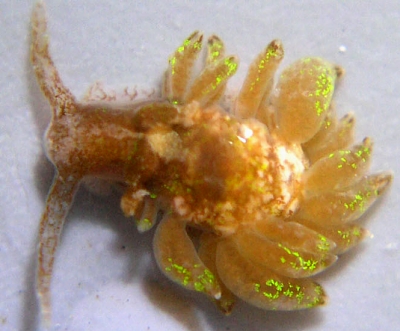
Hi there,
I recently found what I believe to be a nudibranch in my reef aquarium. It was perched on the tip of a gorgonian just after the main lights came on in the tank and one hour after the actinics had been on. I'm not sure if it's important, but it happened to be perched on the tip of the gorgonian where I had recently broken off a fragment.
I removed it via siphon and tooks some images of it in hopes you can ID it. It appears to be about 4.5mm in length. If it's not predacious, I'd love to keep it in my tank.
Locality: Aquarium, Less than 1m, California, USA, Aquarium, 15 Aug 2006 PDT, Perched on tip of octocoral. Length: Approx 4.5 mm. Photographer: Jon Humphreys.
Thanks for any insight,
Jon
jon@dogs-breakfast.com
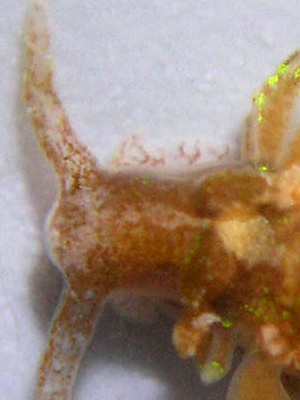
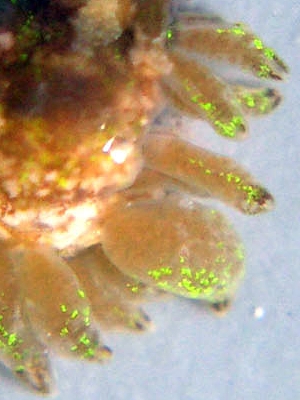
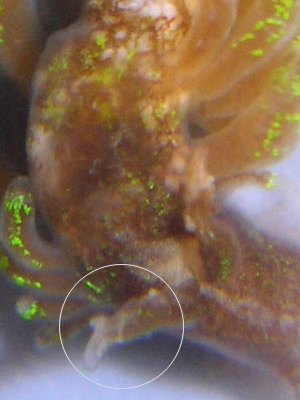
Dear Jon,
It is certainly an aeolid nudibranch but not one I recognise. The only gorgonian feeding aeolids belong to the genus Phyllodesmium. Many species of the genus are solar-powered through their removal of zooxanthellae from the soft-corals they feed on. Your animal has a brown network on the foot and body, which suggests that it may have modified digestive gland ducts to harbour zooxanthellae. However species of Phyllodesmium lack cnidosacs, but in your photos there seem to be obvious cnidosacs at the tip of the cerata, so it is unlikely your animal is a Phyllodesmium.
One other possibility is that your aeolid belongs to the family Aeolidiidae, like the species of Aeolidiopsis which feed on Palythoa. In the lower right photo I have ringed one of the rhinophores, which seem to have little tubercles or branches. Species of Aeolidiopsis have branched rhinophores.
I may be wrong but I suspect your animal is not eating your gorgonian but it may be eating Palythoa, if you have any in your aquarium. I know you will probably just want to squash it, but unless it is part of a large population in your aquarium, it shouldn't do much harm on its own. I would very much like to know if it grows much bigger, and what it actually eats, before you kill it.
Best wishes,
Bill Rudman
Polyp-feeding nudibranch
December 7, 2002
From: Mark Johnson
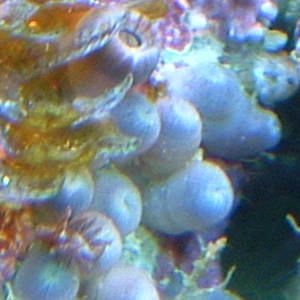
Hello,
I bought some Caulerpa prolifera algae and it came on a piece of Live Rock with all kinds of critters and algae as well as a small colony of button polyps. Anyway I have had this for about 2 weeks now and all of a sudden I noticed my button polyps closing up and after 2-3 days noticed this little critter crwling on it. Upon closer inspection and a little research thanks to this site it seem to be some sort of a Nudibranch. I found a photo of Berghia verrucicornis that looks very similar except mine is totally brown with a light brown body. It is the exact same color as my brown polyps and its spikes on its back are the same size and shape as the tentacles on my brown button poly. I read that they eat Aiptasia and was wondering if they eat brown button polyps as well. It crawls on the polyps but doesn't seem to be causing any physical damage but it keeps the polyps from opening and I'm afraid they will starve. Or when/if the Nudibranch gets bigger it will start harming them.
Mark Johnson
rmjohnson144@adelphia.net
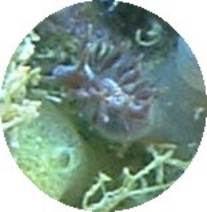
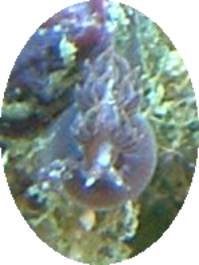
Dear Mark,
Your animal certainly looks like an aeolid nudibranch but it may be a species we don't know about. Most aeolids feed on cnidarians of some sort, some specialising on hydroids, some on sea anemones, or hard corals or sift corals. Most are very specific in their food choice. I am not sure what species your 'button polyp' is, but it looks quite like the one in a recent message, which was also being eaten by a nudibranch. Since we don't know what your slug is, I can't give you any advice on how 'dangerous' it is. However since you bought the live rock for the Caulerpa the button polyps and the nudibranch are a bonus. I am biased, but my advice would be to let 'nature' take its course, and just see what happens. It is possible the aeolid has quite a bit of growing to do. If so, we would have a much better idea of its identify if it were allowed to grow a bit bigger, and unless you find you have an invasion of these slugs, I doubt it will do much damage to the polyps.
If you are brave and leave it alive, I would be intersted in some followup information in a few weeks and some photos
Best wishes,
Bill Rudman
Nudibranch or sea slug pest in my aquarium
October 29, 2002
From: ronman
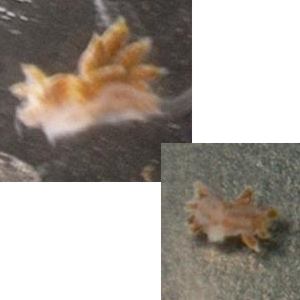
I have discovered a pest. I think they are nudibranchs - they are small like a ball of a pen and what ever they are, they are attacking my polyps. What could this be and what should I do about it?
ronman
sebag@videotron.ca
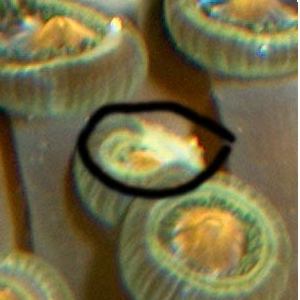
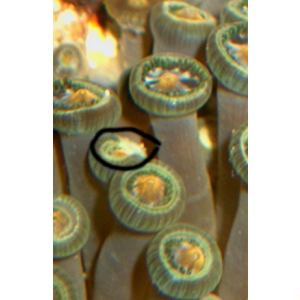
Dear Ronman,
Describing nudibranchs as 'pests' is a very brave thing to do on the Sea Slug Forum - maybe that's why you didn't give us a full name. But I forgive you.
Your little animal certainly looks like it could be an aeolid nudibranch. Although I can't see much detail, it certainly seems to have typical aeolid cerata on its back. There are species of aeolid nudibranch which eat Palythoa and some that eat anemones. Have a look at the Fact Sheet on Palythoa feeders for some background information. It is possible your animals are juveniles of one of the species there.
What should you do? Well if it was me I would wait with interest to see what they grew into and just hope they didn't eat too many of your polyps. However I suspect your attitude to them will be a little sterner, which is unfortunate. However I don't know of any simple way of getting rid of nudibranchs from aquaria.
Best wishes,
Bill Rudman
Another Palythoa-feeding slug
October 17, 2002
From: Michael Mrutzek
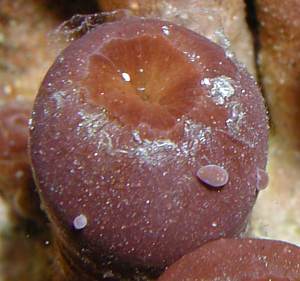
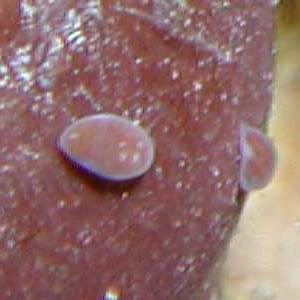
Hey Bill
Hope all is well?? I saw two other Slugs? in my tanks over here. One definitely eats Palythoa and the other one will eat Stolonifera types. The first one is at maximum 3 mm long. Normally I put the Palythoa in freshwater for 3 minutes and so most of them will die.
Is this interesting?
Michael
Michael@meeresaquaristik.de
Michael Mrutzek, 2002 (Oct 17) Another Palythoa-feeding slug. [Message in] Sea Slug Forum. Australian Museum, Sydney. Available from http://www.seaslugforum.net/find/8185Dear Michael,
I am interested in any natural history information on feeding, breeding etc so yes your observations are interesting, especially if the animals are identifiable. This animal is in fact a flatworm, but as I mention separately, your second animal is very interesting
Best wishes,
Bill Rudman
Palythoa -feeding nudibranch
October 16, 2002
From: Michael Mrutzek
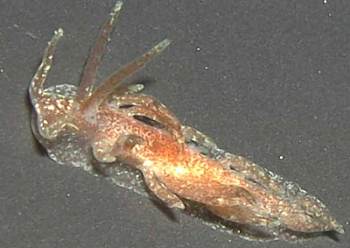
Hello Bill
Here a Photo of a Slug which eats crustaceans in my aquarium. Normally it is on Palythoa and Epizoanthius
Photo: Aquarium
Length: 6 mm
Have a nice Weekend
Michael
Michael@meeresaquaristik.de
Mrutzek, M., 2002 (Oct 16) Palythoa -feeding nudibranch. [Message in] Sea Slug Forum. Australian Museum, Sydney. Available from http://www.seaslugforum.net/find/8183Dear Michael,
I am puzzled to hear that this species eats crustacea, as I have never heard of an aeolid doing that. I suspect that it is a species of Aeolidiopsis [see Fact Sheet] but it doesn't look much like the three described species. The rhinophores are very long.
Best wishes,
Bill Rudman
